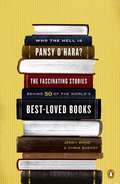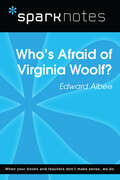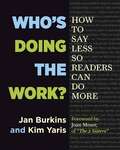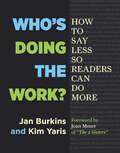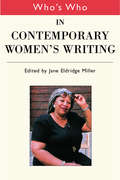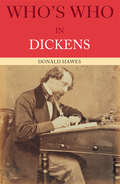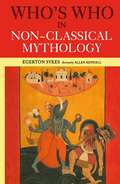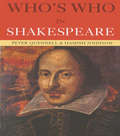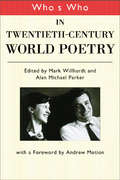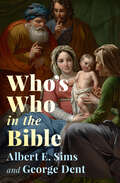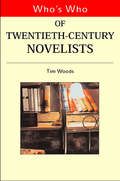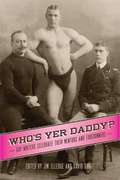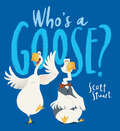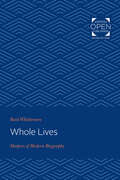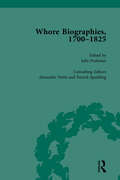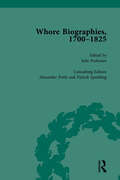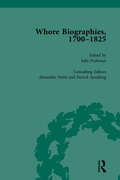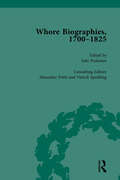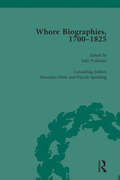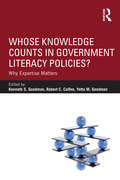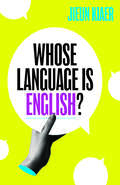- Table View
- List View
Who the Hell is Pansy O'Hara?: The Fascinating Stories Behind 50 of the World's Best-Loved Books
by Jenny Bond Chris SheedyThe captivating stories behind fifty of the greatest authors and their most famous literary creations Before Who the Hell is Pansy O'Hara ?, there had never been a single volume that explored the backstories of so many of the greatest books in the English language. A work sure to captivate all lovers of language and literature, it reveals in short, pithy chapters, the lives, loves, motivations, and quirky, fascinating details involving fifty of the best-loved books of the Western world. When stacked up, the original manuscript of Gone With the Wind stood taller than Margaret Mitchell, its 4' 9 1/2" author Ian Fleming, creator of James Bond, was part of the Allied team that cracked the Nazi's Enigma code. Leo Tolstoy's wife copied War and Peace by hand . . . seven times. From The Great Gatsby to Harper Lee, from Jaws to J. K . Rowling, Who the Hell Is Pansy O'Hara? offers an entertaining and informative journey through the minds of writers and the life experiences that took these amazing works from notion to novel. .
Who's Afraid of Agatha Christie
by FagihFirst Published in 2000. Routledge is an imprint of Taylor & Francis, an informa company.
Who's Afraid of Jane Austen? How to Really Talk About Books You Haven't Read
by Henry HitchingsEver wondered how some people seem to have an opinion on every book ever published? Nowadays, there are so many books: how can anyone be well read anymore? Well, help is at hand. Let Henry Hitchings educate you in the invaluable skill of literary bluffing in this survivor's guide to talking about books you haven't read. With tips on how to bluff with confidence using quotable insights and invaluable trivia, Henry Hitchings covers all the great books you ought to have read but haven't got round to yet. If you want to be able to hold your own in a debate about Stephen Hawking or Philip Roth or perhaps you find Shakespeare or Dostoevsky intimidating, then look no further. Including literary heavyweights such as Ulysses, Bleak House and War and Peace this guide will equip you with all the bookish information you need to bluff your way through any scenario, be it a vital exam, an in-depth conversation at the pub or chatting up the potential love of your life. Contents includes, Jane Austen, Shakespeare, Henry James, James Joyce, Proust, Homer, Virgil, Tolstoy, Dostoevsky, Dickens, various contemporary writers, the Bible, the Koran, fairy tales, select bestsellers and some poetry.
Who's Afraid of Jane Austen? How to Really Talk About Books You Haven't Read
by Henry HitchingsEver wondered how some people seem to have an opinion on every book ever published? Nowadays, there are so many books: how can anyone be well read anymore? Well, help is at hand. Let Henry Hitchings educate you in the invaluable skill of literary bluffing in this survivor's guide to talking about books you haven't read. With tips on how to bluff with confidence using quotable insights and invaluable trivia, Henry Hitchings covers all the great books you ought to have read but haven't got round to yet. If you want to be able to hold your own in a debate about Stephen Hawking or Philip Roth or perhaps you find Shakespeare or Dostoevsky intimidating, then look no further. Including literary heavyweights such as Ulysses, Bleak House and War and Peace this guide will equip you with all the bookish information you need to bluff your way through any scenario, be it a vital exam, an in-depth conversation at the pub or chatting up the potential love of your life. Contents includes, Jane Austen, Shakespeare, Henry James, James Joyce, Proust, Homer, Virgil, Tolstoy, Dostoevsky, Dickens, various contemporary writers, the Bible, the Koran, fairy tales, select bestsellers and some poetry.
Who's Afraid of Virginia Woolf (SparkNotes Literature Guide Series)
by SparkNotesWho's Afraid of Virginia Woolf (SparkNotes Literature Guide) by Edward Albee Making the reading experience fun! Created by Harvard students for students everywhere, SparkNotes is a new breed of study guide: smarter, better, faster. Geared to what today's students need to know, SparkNotes provides: *Chapter-by-chapter analysis *Explanations of key themes, motifs, and symbols *A review quiz and essay topicsLively and accessible, these guides are perfect for late-night studying and writing papers
Who's Doing The Work?: How To Say Less So Readers Can Do More
by Jan Burkins Kim YarisBest-selling authors Dr. Jan Burkins and Kim Yaris rethink traditional teaching practices in Who's Doing the Work: How to Say Less So Readers Can Do More. They review some common instructional mainstays such as read-aloud, guided reading, shared reading, and independent reading and provide small, yet powerful, adjustments to help hold students accountable for their learning. Next generation reading instruction is much more responsive to student needs and aims to remove some of the scaffolding that can hinder reader development. Instead of relying on teacher prompts, Who's Doing the Work asks teachers to have students take ownership of their reading by managing their challenges independently and working through any plateaus they encounter. Whether you are an elementary teacher, literacy coach, reading specialist, or parent, Who's Doing the Work provides numerous examples on how to readjust the reading process and teach students to gain proficiency and joy in their work.
Who's Doing the Work?: How to Say Less So Readers Can Do More
by Jan Burkins Kim YarisBest-selling authors Dr. Jan Burkins and Kim Yaris rethink traditional teaching practices Who's Doing the Work: How to Say Less So Readers Can Do More. They review some common instructional mainstays such as read-aloud, guided reading, shared reading, and independent reading and provide small, yet powerful, adjustments to help hold students accountable for their learning.Next generation reading instruction is much more responsive to student needs and aims to remove some of the scaffolding that can hinder reader development. Instead of relying on teacher prompts, Who's Doing the Work asks teachers to have students take ownership of their reading by managing their challenges independently and working through any plateaus they encounter. Whether you are an elementary teacher, literacy coach, reading specialist, or parent, Who's Doing the Work provides numerous examples on how to readjust the reading process and teach students to gain proficiency and joy in their work.
Who's Who in Contemporary Women's Writing (Who's Who Ser.)
by Jane Eldridge MillerUnique in its breadth of coverage, Who's Who in Contemporary Women's Writing is a comprehensive, authoritative and enjoyable guide to women's fiction, prose, poetry and drama from around the world in the second half of the twentieth century. Over the course of 1000 entries by over 150 international contributors, a picture emerges of the incredible range of women's writing in our time, from Toni Morrison to Fleur Adcock- all are here. This book includes the established and well-loved but also opens up new worlds of modern literature which may be unfamiliar but are never less than fascinating.
Who's Who in Dickens (Who's Who)
by Donald HawesWho's Who in Dickens is an accessible guide to the many characters in Charles Dickens' fiction. Dickens' characters are strikingly portrayed and have become a vital part of our cultural heritage - Scrooge has become a by-word for stinginess, Uriah Heep for unctuousness. From the much loved Oliver Twist to the fact-grubbing Mr Gradgrind, the obstinate Martin Chuzzlewit to the embittered Miss Havisham, this book covers the famous and lesser known characters in Dickens.The book contains a physical and psychological profile of each character, a critical look at his characters by past and present influential commentators and over forty illustrations of major characters drawn by Dickens' contemporaries.
Who's Who in Lesbian and Gay Writing (The\routledge Who's Who Ser.)
by Gabriele GriffinWho's Who in Lesbian and Gay Writing is a lively and accessible biographical guide to lesbian and gay literary culture, from Sappho to modern pulp fiction. Featuring authors of works with lesbian or gay content as well as known lesbian and gay writers, this volume opens the boundaries of this field to include the writers of popular cultural fiction. It places these alongside the canon of poets, dramatists and novelists, to acknowledge the importance of pop culture to gay and lesbian communities. It includes fascinating entries on authors from W.H. Auden to Alice Walker, James Baldwin to Virginia Woolf. Also included are those such as Judith Butler who have theorised lesbian and gay culture and writing, or have contributed to the uncovering and charting of this vibrant literary history. Fully cross referenced, and with suggestions for further reading, this book offers an invaluable guide to a rich and varied literary culture and is indispensable for anyone with an interest in lesbian and gay writing.
Who's Who in Non-Classical Mythology
by Alan Kendall Edgerton Skyes Egerton SykesFirst published in 2001. Routledge is an imprint of Taylor & Francis, an informa company.
Who's Who in Shakespeare (Who's Who)
by Peter Quennell Hamish JohnsonWho's Who in Shakespeare presents a complete and handy guide to the men and women who throng Shakespeare's plays. It provides:* detailed biographical information on each leading figure* analyses of the role and significance of each minor figure* a reliable guide to the huge Shakespearian canon for student and teacher* quotations from famous critics* useful information on some of Shakespeare's sources.From Antonio to Yorick, Macbeth to Mercutio, this book embraces the breadth and depth of the world's most important playwright.
Who's Who in Twentieth Century World Poetry (The\routledge Who's Who Ser.)
by Andrew Motion Alan Michael Parker Mark Willhardt Poet LaureateThe definitive biographical guide to poetry throughout the world in the twentieth century and the only book of its kind to look at non-English language poets in such detail. Written in lively prose, with over 900 entries by over 75 international contributors, it brings a uniquely global perspective to bear on modern verse, encapsulating the lives and works of a vast array of poets in precise, compact detail alongside expert critical comment. Who's Who in Twentieth Century World Poetry is a scholarly and hugely enjoyable guide through the diverse arena of modern international poetry.
Who's Who in the Bible
by Rev Albert E. Sims And Rev. George DentThis detailed and accessible A–Z reference offers clear and authoritative biographical information on the Bible&’s numerous characters. From Aaron and Abel to Zohar and Zurishaddai, Who&’s Who in the Bible presents essential information on the many individuals who appear in the Old and New Testaments. Each entry provides the reader with a complete listing of where the individual is mentioned in the Bible, making it easy to follow the continuity of his or her role throughout the scriptures. Supplementary materials include a pronunciation guide, a timeline of the kings of Judah and Israel, and the genealogies of Jesus according to Matthew and Luke.
Who's Who of Twentieth Century Novelists: Null
by Tim WoodsTaking in novelists from all over the globe, from the beginning of the century to the present day, this is the most comprehensive survey of the leading lights of twentieth century fiction. Superb breadth of coverage and over 800 entries by an international team of contributors ensures that this fascinating and wide-ranging work of reference will be invaluable to anyone with an interest in modern fiction. Authors included range from Joseph Conrad to Albert Camus and Franz Kafka to Chinua Achebe. Who's Who of Twentieth Century Novelists gives a superb insight into the richness and diversity of the twentieth century novel.
Who's Yer Daddy?: Gay Writers Celebrate Their Mentors and Forerunners
by David Groff Jim ElledgeWho's Yer Daddy? offers readers of gay male literature a keen and engaging journey. In this anthology, thirty-nine gay authors discuss individuals who have influenced them--their inspirational "daddies." The essayists include fiction writers, poets, and performance artists, both honored masters of contemporary literature and those just beginning to blaze their own trails. They find their artistic ancestry among not only literary icons--Walt Whitman, Oscar Wilde, André Gide, Frank O'Hara, James Baldwin, Edmund White--but also a roster of figures whose creative territories are startlingly wide and vital, from Botticelli to Bette Midler to Captain Kirk. Some writers chronicle an entire tribal council of mentors; others describe a transformative encounter with a particular individual, including teachers and friends whose guidance or example cracked open their artistic selves. Perhaps most moving are the handful of writers who answered the question literally, writing intimately of their own fathers and their literary inheritance. This rich volume presents intriguing insights into the contemporary gay literary aesthetic.
Who's a Goose?
by Scott StuartFrom a barrel of monkeys to giraffes in a tower, this hilarious animal rhyming story is all about collective nouns!If one goose is a goose, and two gooses are geese, then why is one moose a moose, but two moose aren't meese?Learn alongside Bruce and Bill as they explore the hilarity of collective nouns!With a rhyming text, eye-catching artwork, and plenty of laugh-out-loud moments, serious Bruce and silly Bill are two gaggling geese sure to make kids giggle! A pitch-perfect read-aloud just right for group storytime.
Whole Lives: Shapers of Modern Biography
by Reed WhittemoreOriginally published in 1989. In this companion volume to the acclaimed Pure Lives, Reed Whittemore probes the often-complex motives behind the relationships of modern biographers to their subjects. Whittemore's description of biography's uneven path toward comprehensive character study begins with Thomas Carlyle, whose biography of Frederick the Great broke with tradition by tracing the roots of its subject's character to childhood trauma. (A strict disciplinarian, Frederick's father once considered having his rebellious teenage son executed.) Whittemore examines the work of Leslie Stephen, the Dictionary of National Biography's first editor, who admired Carlyle but disliked his style—and was convinced that Carlyle disliked him. And in a chapter on Sigmund Freud, Whittemore traces the revolution in writing biography that began with Freud's speculations on the nature and origin of Leonardo da Vinci's homosexuality. Few have escaped Freud's influence. While Leon Edel argues that biographers should not psychoanalyze their subjects, his biography of Henry James does precisely that. Richard Ellman tempers his impulse for Freudian probing of Joyce, Yeats, and Oscar Wilde with the explication of their often difficult works. Kenneth Lynn's recent biography of Hemingway takes the opposite approach. "The Hemingway industry," Whittemore explains, "is like Marilyn Monroe's in having much of the sensational in it, including suicide, so that the problems of having to deal with Hemingway as a writer, good or bad, can always be put on the back burner for a few chapters while Hemingway the braggart and liar performs." Thomas Parton and Benjamin Franklin, Virginia Woolf and Elizabeth Barrett Browning, Erik Erikson and Martin Luther, biographers and their subjects continue to engage our attention. Whole Lives offers an informative—and refreshingly informal—look at one of the most enduringly popular genres.
Whore Biographies, 1700-1825, Part I Vol 3
by Julie PeakmanFocuses on autobiographies and biographies of courtesans, directories of whores, erotic poems dedicated to harlots, jocular descriptions of prostitutes and jest books on strumpets. These provide sources for the study of sexuality, gender, women's studies and the literature and history of the eighteenth century.
Whore Biographies, 1700-1825, Part II vol 5
by Julie PeakmanAcross eight volumes, this two-part collection of selected texts focuses on autobiographies and biographies of courtesans, directories of whores, erotic poems dedicated to harlots, jocular descriptions of prostitutes and jest books on strumpets.
Whore Biographies, 1700-1825, Part II vol 6
by Julie PeakmanAcross eight volumes, this two-part collection of selected texts focuses on autobiographies and biographies of courtesans, directories of whores, erotic poems dedicated to harlots, jocular descriptions of prostitutes and jest books on strumpets.
Whore Biographies, 1700-1825, Part II vol 7
by Julie PeakmanAcross eight volumes, this two-part collection of selected texts focuses on autobiographies and biographies of courtesans, directories of whores, erotic poems dedicated to harlots, jocular descriptions of prostitutes and jest books on strumpets.
Whore Biographies, 1700-1825, Part II vol 8
by Julie PeakmanAcross eight volumes, this two-part collection of selected texts focuses on autobiographies and biographies of courtesans, directories of whores, erotic poems dedicated to harlots, jocular descriptions of prostitutes and jest books on strumpets.
Whose Knowledge Counts in Government Literacy Policies?: Why Expertise Matters
by Robert C. Calfee Kenneth S. Goodman Yetta M. GoodmanAccountability, in the form of standardized test scores, is built into many government literacy policies, with severe consequences for schools and districts that fail to meet ever-increasing performance levels. The key question this book addresses is whose knowledge is considered in framing government literacy policies? The intent is to raise awareness of the degree to which expertise is being ignored on a worldwide level and pseudo-science is becoming the basis for literacy policies and laws. The authors, all leading researchers from the U.S., U.K., Scotland, France, and Germany, have a wide range of views but share in common a deep concern about the lack of respect for knowledge among policy makers. Each author comes to the common subject of this volume from the vantage point of his or her major interests, ranging from an exposition of what should be the best knowledge utilized in an aspect of literacy education policy, to how political decisions are impacting literacy policy, to laying out the history of events in their own country. Collectively they offer a critical analysis of the condition of literacy education past and present and suggest alternative courses of action for the future.
Whose Language Is English?
by Jieun KiaerAn exhilarating new account of the English language, from British colonialism to the age of social media, emphasizing dynamism and democratization Whose language is English? Although we often think of it as native to one place, today there are many Englishes. About seventy-five countries are now using English as their official or first language, and the number of people speaking it around the world continues to rise. But the makeup of the English-speaking population is changing. The proportion of speakers for whom English is a first language, for instance, is decreasing, due to the explosion in popularity of English as a second language. In this ambitious book, Jieun Kiaer explores the lives of English words in the twenty-first century, when the creation and use of language has become an increasingly dynamic, interactive, and diverse process in which ordinary people have taken leading roles—offering such coinages as “flexitarian,” “MeToo,” “glow up,” and “shitizen” to “No sabo kids” and beyond. As English language grows ever more diverse, Kiaer believes, we need a paradigm shift. We must acknowledge that all varieties of English are languages in their own right when they are used by a community of speakers. English is a language that belongs to everyone. Considering the effects of social media, the Covid-19 pandemic, virtual work, globalization, and artificial intelligence, Kiaer paints a compelling portrait of a diffuse, rapidly evolving language characterized by creativity and democratization.
